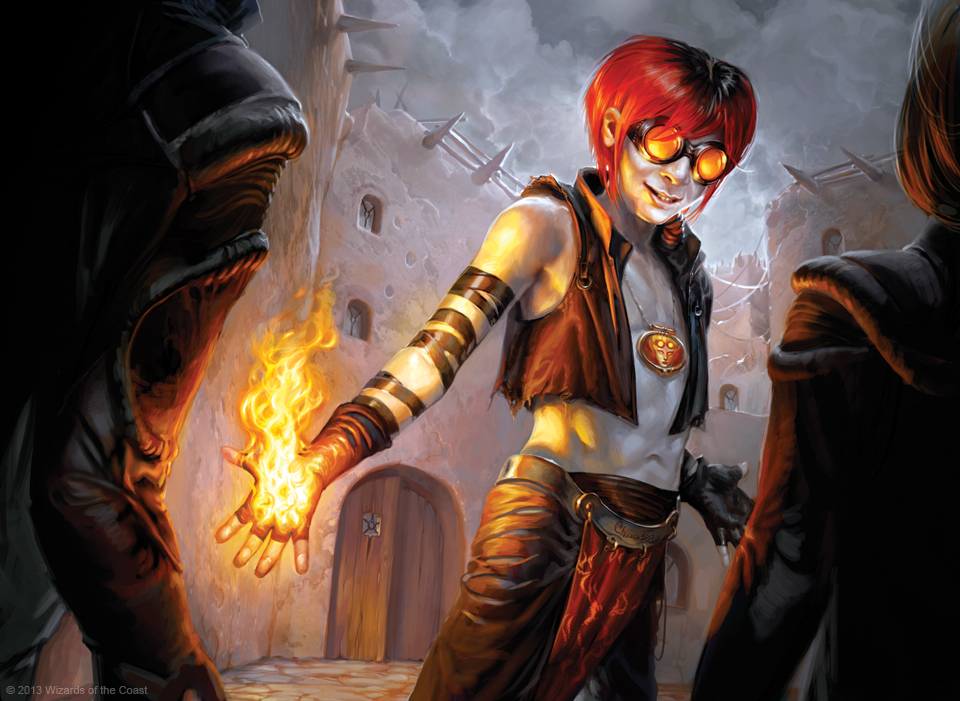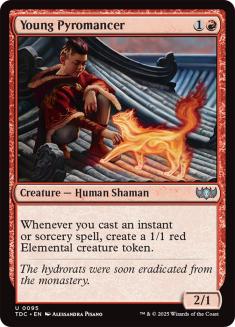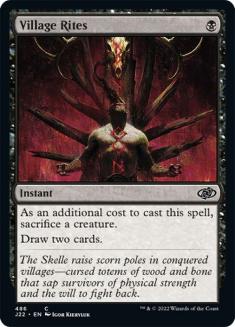Do you believe in love at first sight?
Creatures (15)
- 4 Young Pyromancer
- 4 Stitcher's Supplier
- 4 Dreadhorde Arcanist
- 2 Kroxa, Titan of Death's Hunger
- 1 Archfiend's Vessel
Lands (22)
Spells (23)

The first time I saw the combination of Young Pyromancer and Village Rites in Pioneer, my heart did a little tumble. This is my style of Magic, and the core plan here looked like something with the potential to turn a very static format on its ear. I called my shot and told everyone that this deck was a few tweaks away from being the next big thing. I sat back and waited for the high-profile finishes to come rolling in.
Fast forward three weeks, and I’m still waiting. Sure, the deck has become a fixture in the 5-0 League lists, and there’s an occasional copy floating around the Top 8 of the traditional tournaments. These are the hallmarks of a good deck though. I thought Rakdos Pyromancer (Lurrus) could be a great deck. Meanwhile, lists from week to week remained virtually identical. The archetype had seemingly chosen to stand pat despite producing little in the way of results. What went wrong?
As is common in my articles, I see Rakdos Pyromancer as an opportunity to talk about deck building. Today, I want to propose a theory of stat points for Magic decks. There are categories of tasks you are asking any Magic deck to do. A deck will assign stat points among those categories, and it is often possible to improve one stat at the cost of another. Just like in role-playing games, if your stats are allocated in the wrong manner for the problem at hand, you will often fail. I argue that while Rakdos Pyromancer has an acceptable base number of stat points — i.e. the deck is powerful enough for abstract Pioneer success — the way those points are allocated is not ideal for the present format. Once we’ve identified the improper allocation, we can start taking steps to improve the deck.
The Tasks
The following are the categories I’m using to evaluate decks. I am open to the idea that there are other elements that should be captured, but it feels like this system covers most of the Magic experience.
- Aggression: Simply put, a decks ability to end games. It’s important to understand that this rating isn’t only about dealing damage. Lotus Breach would be a nine or ten on my aggression scale, because it has the fastest goldfish in the entire format. Instead, think of this rating as a measure of the average turn a deck secures an unassailable winning position.
- Disruption: This is a measure of how effectively a deck prevents its opponent from achieving their gameplan. Note that I would define removal such as Fatal Push as disruption for purposes of this rating, Of course, typical elements of disruption like Thoughtseize gain points as well.
- Cohesion: To what extent are a deck’s synergies empowering its cards. A high cohesion rating doesn’t mean that every card in a deck is reliant on another. Instead, it’s a measure of increased capability beyond what the quality of the cardboard involved suggests. A deck that is hyper-interconnected but entirely dependent on a singular piece would not have a strong cohesion stat.
- Acceleration: Again, I’m expanding a traditional Magic term to capture both the accepted meaning and something new. Acceleration ranks how much earlier a deck can do things than is typically expected. Mana acceleration like Llanowar Elves falls under this metric, but things like reanimating a large creature or generating an unusually wide and powerful battlefield through some form of trickery (think Venerated Loxodon) can also move the needle.
- Resiliency: How well a deck stands up to an opponent’s efforts to disrupt you. Redundancy is a huge boon here, as are gameplans that can spiral out of a single card.
- Simplicity: Magic is such an immensely difficult game to play, and the rate of mistakes made by even the best players in the world is high. Ignoring this and trying to analyze all of Magic under some theoretically perfect mode of operation for a given deck is disingenuous. A deck’s ability to minimize the opportunity for pilot error deserves to be a part of its evaluation.
Rating Rakdos Pyromancer
With our metrics defined, the next step is pinning down where Rakdos Pyromancer shines and falters.
Aggression: 3
Games with Rakdos Pyromancer often play out in a similar fashion to games with an old-school deck like early versions of Jund Midrange in Modern. You attempt to neutralize the most essential parts of an opponent’s gameplan with disruption and establish a clock. One of the big problems with Rakdos Pyromancer is the establish-a-clock phase. None of your cards short of Kroxa, Titan of Death’s Hunger can really function as a hammer.
Young Pyromancer, Dreadhorde Arcanist, Lurrus of the Dream-Den… These are cards that need to spend multiple turns on the battlefield before they will spell your opponents’ doom. This means that control over a game must be almost absolute before you can win. In a linear format like Pioneer, this is a true weakness.
Disruption: 4
Thoughtseize is the gold standard for disruption in this deck and the Pioneer format at large. A lot of this decks’ success comes from creating additional virtual copies of the card with Dreadhorde Arcanist. Unfortunately, the deck really doesn’t have much outside of this plan. Kroxa recursion takes a bit of time, and I’m always suspicious of disruption that can be invalidated with raw cards. Meanwhile, removal spells in Pioneer are highly variable. The two terrors of the format, Dimir Inverter and Lotus Breach, have fairly minimal concern for their creatures.
This means that Rakdos Pyromancer has the classic midrange problem of drawing the wrong half of their deck in several matchups. What used to be a quirky but manageable situation is now an insurmountable hurdle, given the power level of the opposing decks and the ability of the London Mulligan to consistently create playable hands. It points to the deck potentially gaining some equity in open decklist situations, but this is mostly irrelevant for the current landscape of Pioneer competition.
Cohesion: 7
I was initially drawn to Rakdos Pyromancer (Lurrus) by just how beautifully synergistic all the pieces appear to be. Thoughtseize protects Dreadhorde Arcanist which recasts Thoughtseize to protect and trigger Young Pyromancer which creates a token to sacrifice to Village Rites which gets Claim to return Dreadhorde Arcanist to the battlefield and the wheels just keep spinning forever. It’s quite brilliant.
The problem is that for all the game actions taken in that sequence, how much was really accomplished? Sure, you’re probably ahead, but if Lotus Breach has its best draw, an opponent is just dead. There’s no question that the cards here lift each other up, but even optimal lines fall a bit short in a very powerful format.
Acceleration: 5
For a Rakdos deck, Rakdos Pyromancer does a nice job of finding ways to advance its schedule. The free spells cast by Dreadhorde Arcanist, reanimations achieved by Claim, and discount rate of card draw on Village Rites leave a very fair deck some capacity for playing ahead to the curve. It doesn’t outshine some of the outliers of the Pioneer format, but I again think this a point in favor of the viability of this archetype when compared against other fair decks.
Resiliency: 9
Here is the feather in the cap for Rakdos Pyromancer. This deck simply will not stay down. So many cards in the deck can generate battlefields on their own, and each piece of the puzzle amplifies your ability to rebound. Transitioning from a hellbent scenario to a dominating position is a common occurrence, and this leaves Rakdos Pyromancer soundly advantaged against the pure control and midrange decks of the format… if only those decks were any good.
Simplicity: 3
Finally, most of Rakdos Pyromancer’s wins are expected to come by inches, not miles. You’ve got to appropriately manage resources, carefully choose targets for disruption, and eek out every single point of damage you can find. You feel brilliant when you win, and when you lose, you’re sure there was something you could have done better. There’s no question that many players love this style of Magic, but you don’t get extra match points for these kinds of wins. The deck is lacking an easy button in a format defined by pure combo and incidental combo-kills. It’s a huge strike against its viability.
The Path Forward
Thinking about Rakdos Pyromancer and the Pioneer format, one point becomes glaringly clear: far too much of this deck’s power is allocated to its resiliency. You simply are not facing matchups that demand the level of staying power shown here. Sure, it’s nice to make Azorius Control squirm, but if Rakdos Pyromancer plans to ascend to the top tier, it has got to make headway against the decks that actually matter.
Let’s look at some builds that are wisely trading in a suboptimal skill for some more useful tricks.
- – Cohesion, Resiliency, Disruption
- + Aggression
Creatures (25)
- 3 Young Pyromancer
- 4 Bloodsoaked Champion
- 4 Stitcher's Supplier
- 3 Knight of the Ebon Legion
- 4 Mire Triton
- 3 Kroxa, Titan of Death's Hunger
- 4 Fiend Artisan
Lands (20)
Spells (15)
Sideboard

I had intended to fill this section entirely with my own lists, but shortly before press time I came upon this list from BeardedCaveman and it was just too good not to share. Caveman correctly identified the problems inherent in the archetype and gave up Call of the Death-Dweller, Dreadhorde Arcanist, and some superfluous removal to get some beatdowns going. Not only does Caveman pick up capable one-drops in Knight of the Ebon Legion and Bloodsoaked Champion, they also found a sweet bridge between the two plans in Fiend Artisan. There’s some tension playing the card alongside increased numbers of Kroxa, but smart players will juggle resources appropriately. Mire Triton feels below the bar for Pioneer power level, but I get wanting more fuel for Fiend Artisan.
I’m sad to see smaller numbers of Young Pyromancer in the mix, but with only fifteen spells I certainly understand why. There are a lot of inherent tensions in the packages you’re putting together, and getting these numbers just right is sure to pay dividends. Here’s a look at one of the more aggressive slants I was considering.
Creatures (25)
- 2 Young Pyromancer
- 4 Bloodsoaked Champion
- 4 Scrapheap Scrounger
- 4 Stitcher's Supplier
- 3 Dreadhorde Arcanist
- 4 Rotting Regisaur
- 2 Knight of the Ebon Legion
- 2 Kroxa, Titan of Death's Hunger
Lands (21)
Spells (14)
Sideboard

I’m not going to pretend like losing access to Lurrus is inconsequential, but it’s not the same card it was prior to nerfs. And besides, we no longer want games to go long. We want just enough disruption to allow our threats to close. Switching to the duo of Bloodsoaked Champion and Scrapheap Scrounger means we still have access to an unstoppable army against decks that would attempt to attrition us out. Meanwhile, Rotting Regisaur makes racing Lotus Breach a real possibility. The synergies here are not on par with the chains discussed above, but our deck still forms a cohesive whole that acquiesces to the pressures of the format. Of course, this isn’t the only direction we can go.
- – Resiliency
- + Cohesion, Disruption, Acceleration
Creatures (14)
Planeswalkers (4)
Lands (22)
Spells (20)

Waste Not is starting to show hints of playability in both Modern and Pioneer, and I’m mostly a believer at this point. Again, a strategy shift has brought us away from the core Young Pyromancer engine, but we make up for that with additional tokens provided by Waste Not. Maindeck Duress seems completely acceptable in this format, and I’d rather lean harder on it than on conditional removal. A build like this has the capacity to have its engine go off in a meaningful way that closes out any opportunity for an opponent to win the game rather than just presenting a favorable battlefield. It’s not the only way to add an additional engine and some acceleration to the deck though.
- – Resiliency
- + Cohesion, Acceleration, Aggression
Creatures (21)
- 4 Young Pyromancer
- 4 Bloodsoaked Champion
- 4 Stitcher's Supplier
- 3 Priest of Forgotten Gods
- 4 Dreadhorde Arcanist
- 2 Kroxa, Titan of Death's Hunger
Lands (21)
Spells (18)

Priest of Forgotten Gods hasn’t gotten a ton of run in Pioneer yet, but it’s another card that can really take advantage of Young Pyromancer’s tokens, and push us ahead of opponents. I’ve made sure this deck does a better job of empowering Pyromancers with a couple of maindeck Cling to Dust. Access to a few more cheap sorceries as well as a return to Claim should also keep the ball rolling. Still, were asking a lot of our disposable creatures, and that’s why I’ve added Bloodsoaked Champion. Not only is this upping our aggression score, it’s shoring up our engine with Priest of Forgotten Gods. This deck feels like one of the more conservative reworks contained here, but still seems like a better allocation of our stat points.
Despite all these different looks at Rakdos Pyromancer, we never really found away to improve its simplicity stat. This is a small-ball deck that is always going to be demanding of its pilot. Despite that fact, it shows a lot of promise as well as branching paths forward.
There’s just no reason we should continue to see the initial 75 appear in the queues. It was a brilliant piece of deckbuilding, but it proved itself to be a foundational work, not the way forward. Our task now is to figure out how to move this deck to the top of the metagame. Hopefully, these are the first steps.




